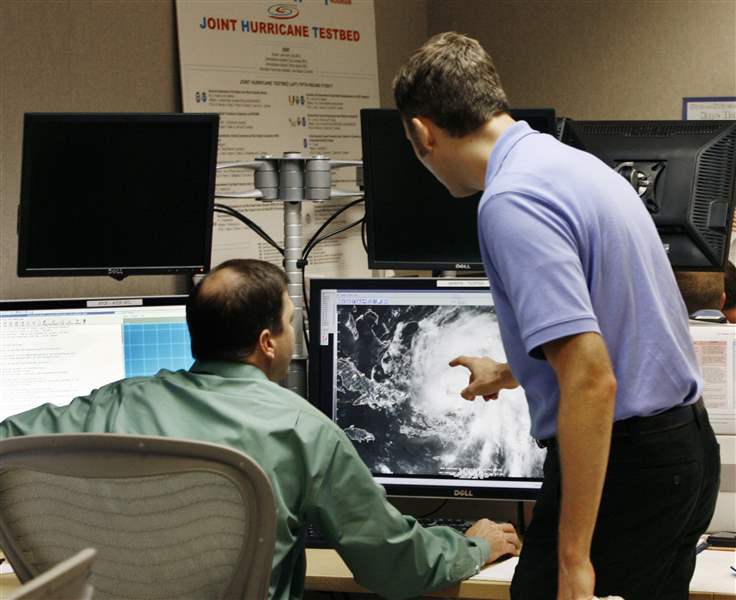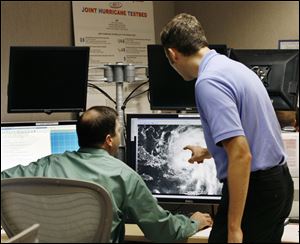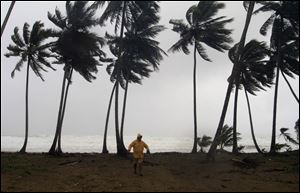
Southeast residents bracing for Hurricane Irene
8/23/2011
Hurricane Specialists at the National Hurricane Center Dan Brown left, and Eric Blake right, review the track and intensity of Hurricane Irene on Tuesday, Aug. 23, 2011, in Miami.
ASSOCIATED PRESS

Hurricane Specialists at the National Hurricane Center Dan Brown left, and Eric Blake right, review the track and intensity of Hurricane Irene on Tuesday, Aug. 23, 2011, in Miami.
MIAMI — Officials and residents from Florida to the Carolinas stocked up on supplies, dusted off evacuation plans and readied for the worst as Irene, the first hurricane to threaten the U.S. in three years, churned over tropical waters after cutting a destructive path through the Caribbean.
Federal officials warned the storm could flood streets and knock down power lines as far north as New England.
Hurricane Irene, which already has raked the Caribbean, could cause serious problems along the entire Eastern Seaboard, Federal Emergency Management Agency administrator Craig Fugate said Tuesday during a conference call with reporters. Fugate urged people not to become complacent, even though the forecast is still uncertain and the storm may be days from hitting the U.S.
"We need to remind people, hurricanes are not just a Southern thing. This could be the Mid-Atlantic and the northeast coast," Fugate said. "We've got a lot of time for people to get ready, but we don't have forever."
Officials on North Carolina's Okracoke Island — where Irene appeared to be taking dead aim as of Tuesday — were taking no chances. Tourists were ordered to evacuate Wednesday, while residents were told to be off the island by Thursday, said Tommy Hutcherson, who serves on the local board that issues such orders.
Hutcherson, who also owns the Ocracoke Variety Store, said authorities have to issue such orders early because of the limited capacity of the ferries. Still, that doesn't mean everyone will leave.
"I'll be here," said Hutcherson, a 29-year resident who has ridden out numerous past storms. "A lot of the locals will choose to stay."
The barrier island is only accessible by boat. It is 16 miles long and mostly undeveloped, with a town at the southern tip.
Caitlin Blue, who works at the Kure Beach Fishing Pier, said Tuesday employees were preparing to board up the windows.
"That's really all you can do," said Blue, 17. "Everybody's a little apprehensive, especially the owner of the pier. This one is supposed to come right down on us."

A man walks away from Los Yayales beach after watching the sea surge due to the approach of Hurricane Irene to Nagua, in the northern coast of the Dominican Republic, Monday, Aug, 22, 2011. A strengthening Category 2 Hurricane Irene roared off the Dominican Republic's resort-dotted northern coast on Monday night, whipping up high waves and torrential downpours on a track that could slam it into the U.S. Southeast as a major storm by the end of the week.
The Kure pier has been rebuilt twice after being destroyed by hurricanes — Hazel in 1954 and the double hit in 1996 from Bertha and Fran.
Many people already have begun stocking up on essentials such as bottled water, gasoline and plywood for boarding up windows. But on North Carolina's Wrightsville Beach, a popular tourist destination, only a few wispy clouds dotted the sky on a 90-degree day. Bronzed sunbathers strolled around in bathing suits and towels, and traffic was heavy — most cars were headed toward the beach, not away from it.
Most in the area weren't panicking — but they were getting ready. Irene was the main topic of conversation at Craft American Hardware, not far from Wrightsville Beach, where people were trooping all day to pick up emergency supplies for the storm.
"Water, batteries, flashlights and now I'm going to get my grocery shopping done," said Sally Godwin, carrying two large jugs of fresh water out of the store with her. "I live at the beach, and they always evacuate it the day before. I have to make sure all my little stuff's taken care of."
It's possible Irene will make landfall over the North Carolina coast sometime Saturday, then move to the north into the Chesapeake Bay sometime Sunday. However, because such projections can be uncertain, it's also possible Irene could straddle the coast.
Fugate and National Hurricane Center director Bill Read said Irene could cause problems even over open water. New England is particularly vulnerable to heavy rains because the soil is already saturated from summer storms, which could raise the threat of flash flooding.
If Irene does move into the Mid-Atlantic area, it could threaten plans for dedicating a memorial to Martin Luther King Jr. Fugate said officials were discussing whether to hold Sunday's dedication ceremony. Tens of thousands are expected to attend the event at the National Mall in Washington, D.C.
Irene had already wrought destruction across the Caribbean, giving a glimpse of what the storm might bring to the Eastern Seaboard. In Puerto Rico, more than a million people were without power, and President Barack Obama declared an emergency there. At least hundreds were displaced by flooding in the Dominican Republic, forced to take refuge in schools and churches.
Irene was making its way toward the Bahamas and the Turks and Caicos Islands on Tuesday. The prime minister of the Bahamas pleaded with islanders in low-lying areas to seek higher ground, and also urged people to stock up on water, food, flashlights, first aid kits and other supplies. On the Turks and Caicos Islands, residents were putting up hurricane shutters and tourists were retreating to their hotels.
On Tuesday afternoon, Irene was about 55 miles (90 kilometers) south of Grand Turk Island, moving west-northwest at 10 mph (16 kph). Its maximum sustained winds were at 100 mph (160 kph).
In South Carolina, emergency agencies went on alert for what could be the first hurricane to hit there in seven years.
"This is potentially a very serious hurricane," longtime Charleston Mayor Joseph P. Riley Jr. said. He led Charleston's recovery from the massive destruction of Hurricane Hugo's 135 mph winds and waves back in 1989.
It's been more than a century since Georgia has taken a direct hit from a Category 3 storm or greater. That was in 1893, and the last hurricane to make landfall along the state's 100-mile coast was David, which caused only minor damage when it struck in 1979.
On Tybee Island, Ga., 18 miles east of Savannah, officials planned to be on the lookout for fierce rip currents and heavy surf from Irene. Mayor Jason Buelterman said it was possible lifeguards might close the water to swimmers and surfers. On Jekyll Island, about 60 miles south of Savannah, officials were watching forecasts in case measures were needed to protect historic buildings.
Among them are sprawling "cottages" built by the likes of William Rockefeller and other wealthy industrialists in the late 1800s.
If Irene makes it as a major storm to New England, Read drew comparisons to a huge 1938 hurricane that also approached from the South and killed 682 people.
"We're very concerned about what's going to happen in New England," Read said.
Irene could bring much-needed relief to a fire blazing in the Great Dismal Swamp on the North Carolina-Virginia line, however. If the storm stays on its current track, it could soak the smoldering fire that's consumed more than 9 square miles of swamp in both states.